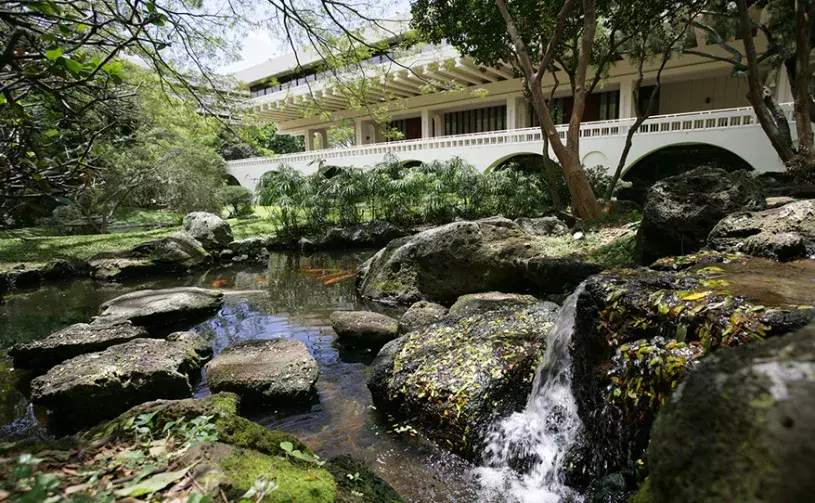
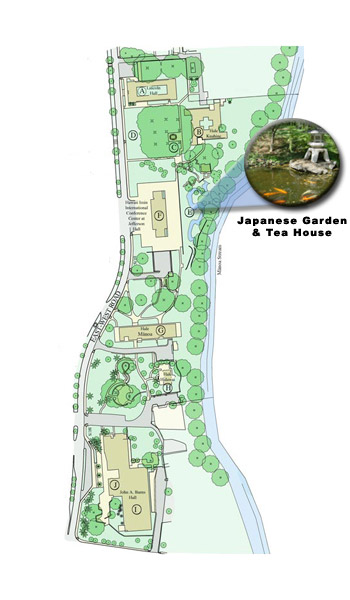
"In my garden
Emperor Meiji (1852 - 1912)
Side by side
Native plants, foreign plants
Growing together."
Of the many words of admiration, perhaps those of the Emperor Meiji best capture the spirit of the East-West Center Japanese garden which adjoins Imin International Conference Center at Jefferson Hall. The garden embodies the East-West Center goal of understanding among nations - its very creation was a cooperative enterprise of East and West. Twenty-two business firms in Japan financed the project, enabling the Center to build the garden, which involved specialists from Asia, the Pacific, and the United States.
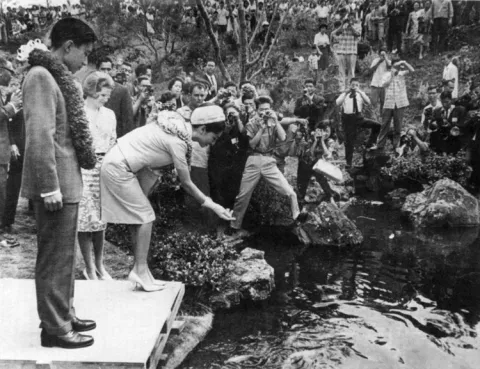
Designed by noted landscape architect, Kenzo Ogata, the garden was completed in November of 1963 and formally presented to the Center by Taizo Ishizaka, president of the Federation of Economic Organizations of Tokyo. During a trip to Hawai'i in 1964, Prince Akihito and Princess Michiko of Japan blessed the garden during a traditional hold and release ceremony of koi (a gift from the Hawai'i Goldfish and Carp Association) into the garden stream. The royal couple also planted a coral shower tree along the pathway leading down to the garden. In 1994, the now Emperor Akihito and Empress Michiko returned to view the garden they had blessed 30 years previous.
The garden abounds in symbolism, from the meandering stream to its Japanese carp. The stream actually has three levels much as a river begins in the mountains, flows through the plains and slows as it reaches the sea. According to Japanese tradition, this symbolizes life, which begins in a fast moving turmoil, steadies in adulthood and slows to a more tranquil, majestic senior citizenship. The water's calm surface is often ruffled by the colorful carp, symbol of valor because it fights its way upstream with persistence. Short cement posts seen in and near the stream represent "remains of a bridge," the round stones represent shoals where "the former bridge has been washed out." All the large stones with moss were collected in Hawai'i and properly placed.
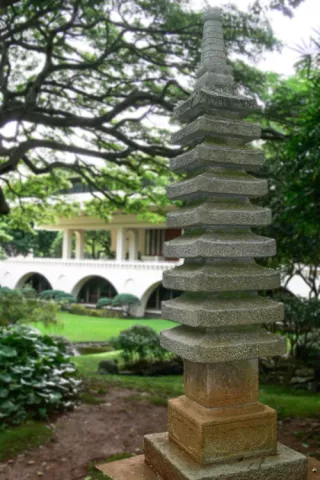
Stone pagoda 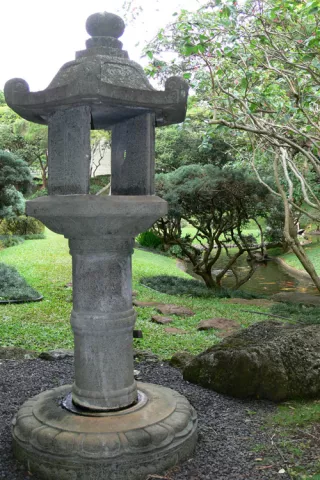
Traveler's lantern
Near the highest waterfall is a nine-tiered stone pagoda, a haven in the mountains. Along the stream are two stone lanterns. One is a traveler's lantern which has illuminated the way for many people in Japan, and is now supposed to light the garden entrance. It is a gift of Kyoto landscape gardener Hakudo Inouye. The other is a "snow reflecting" lantern.
Overlooking the garden is a Japanese teahouse, where traditional tea ceremonies are held.

"In my garden
Emperor Meiji (1852 - 1912)
Side by side
Native plants, foreign plants
Growing together."
Of the many words of admiration, perhaps those of the Emperor Meiji best capture the spirit of the East-West Center Japanese garden which adjoins Imin International Conference Center at Jefferson Hall. The garden embodies the East-West Center goal of understanding among nations - its very creation was a cooperative enterprise of East and West. Twenty-two business firms in Japan financed the project, enabling the Center to build the garden, which involved specialists from Asia, the Pacific, and the United States.

Designed by noted landscape architect, Kenzo Ogata, the garden was completed in November of 1963 and formally presented to the Center by Taizo Ishizaka, president of the Federation of Economic Organizations of Tokyo. During a trip to Hawai'i in 1964, Prince Akihito and Princess Michiko of Japan blessed the garden during a traditional hold and release ceremony of koi (a gift from the Hawai'i Goldfish and Carp Association) into the garden stream. The royal couple also planted a coral shower tree along the pathway leading down to the garden. In 1994, the now Emperor Akihito and Empress Michiko returned to view the garden they had blessed 30 years previous.
The garden abounds in symbolism, from the meandering stream to its Japanese carp. The stream actually has three levels much as a river begins in the mountains, flows through the plains and slows as it reaches the sea. According to Japanese tradition, this symbolizes life, which begins in a fast moving turmoil, steadies in adulthood and slows to a more tranquil, majestic senior citizenship. The water's calm surface is often ruffled by the colorful carp, symbol of valor because it fights its way upstream with persistence. Short cement posts seen in and near the stream represent "remains of a bridge," the round stones represent shoals where "the former bridge has been washed out." All the large stones with moss were collected in Hawai'i and properly placed.

Stone pagoda 
Traveler's lantern
Near the highest waterfall is a nine-tiered stone pagoda, a haven in the mountains. Along the stream are two stone lanterns. One is a traveler's lantern which has illuminated the way for many people in Japan, and is now supposed to light the garden entrance. It is a gift of Kyoto landscape gardener Hakudo Inouye. The other is a "snow reflecting" lantern.
Overlooking the garden is a Japanese teahouse, where traditional tea ceremonies are held.

